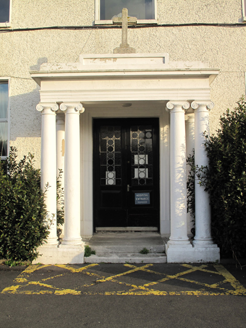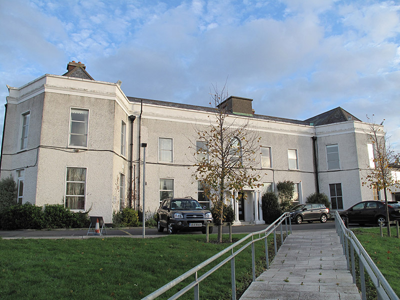Survey Data
Reg No
50030066
Rating
Regional
Categories of Special Interest
Architectural, Historical, Social
Previous Name
Edenmore/Violet Hill
Original Use
House
In Use As
Nursing/convalescence home
Date
1720 - 1740
Coordinates
321011, 238455
Date Recorded
08/10/2014
Date Updated
--/--/--
Description
Attached seven-bay two-storey former house with attic accommodation, built c. 1730, with full-height canted end bays and central Ionic portico to front (south) elevation. Extensions to rear (north) elevation, and recent two-storey building adjoining east elevation. Now in use as nursing home. Hipped natural slate roofs with rendered and red brick chimneystacks, cast-iron water tank and cast-iron rainwater goods, surrounded by raised rendered parapet having render coping. Moulded render cornice to base of parapet. Roughcast rendered walls with smooth render plinth course. Square-headed window openings throughout with raised render reveals, painted masonry sills and replacement windows. Coloured glass panels to ground floor to front of canted-bay to east. Central round-headed window to first floor to front. Portico comprising paired masonry Ionic columns with responding pilasters, supporting entablature, with stepped parapet surmounted by granite cross. Square-headed door opening with render architrave, double-leaf half-glazed timber panelled door, limestone platform and steps. Situated in own grounds, surrounded by more recent hospital buildings. Mature gardens to front.
Appraisal
Edenmore House was originally known as Violet Hill and was the residence of merchant Samuel Dick, who was responsible for the construction of Crescent Cottages workers' housing in Raheny village, as well as a charity school. It acquired its current name in 1825 when it was taken over by John Maconchy and renamed after his family estates in County Longford. The land was acquired by the Dublin & Drogheda Railway Company as the headquarters for the construction of its line in 1842 and Edenmore was the location of a banquet organised to mark the opening of the railway in 1844. Two trains stopped at Raheny and six hundred guests, including Daniel O'Connell, went to Edenmore House, where the army band played for the feast. In 1957 the house was acquired by the Sisters of St. Joseph of Chambery and it has since been used as a hospital and nursing home. Although altered the house retains its original form and features which are indicative of a past grandeur, notably the Ionic portico. This central focal point, along with the canted end bays, creates a pleasing and well-balanced façade.



